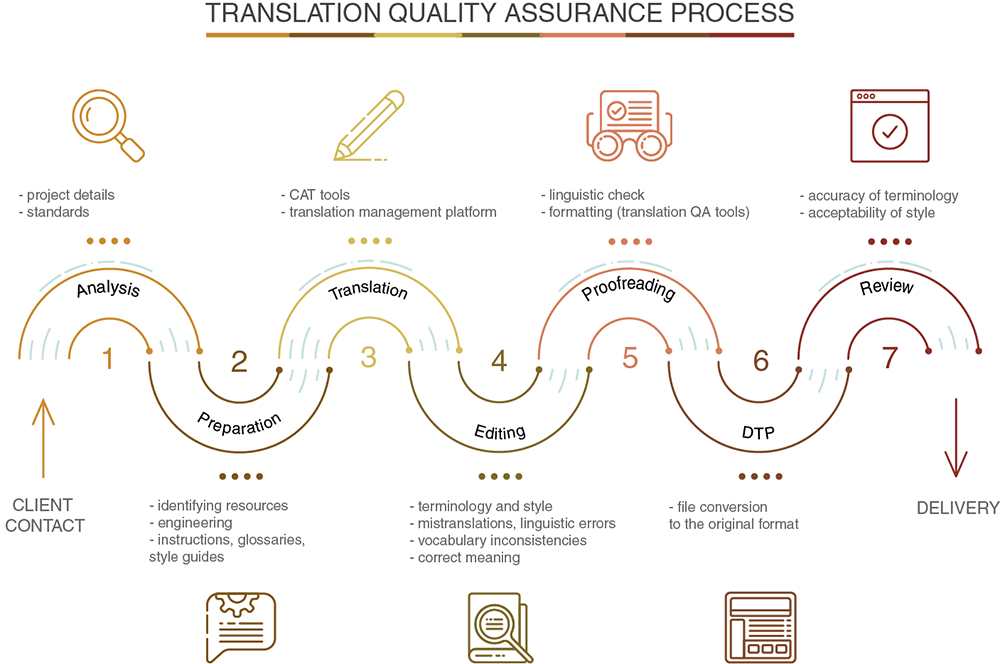Translation quality assurance is essential in any sphere of translation business but can be critical in medical, legal, accounting, and technical documentation. Lousy translation can influence business and in certain cases could even cause a loss of life.
Given the pressures that can be on a translator, I feel that translators need some kind of support. After all, what is the general first thought when someone sees a bad translation? It’s likely that 95% of ordinary people would answer “the translator is guilty.” But is it really so easy? Sometimes translation companies do not go beyond translation quality control, usually made AFTER the translation is already done. But real translation quality assurance should start BEFORE the text comes to the translator. Producing high-quality translations is the outcome of efforts made by all the team members. A translation could fail not only because of a low translator’s qualification but also because of an inferior quality management system.

Remember, the biggest part of the iceberg is beneath the surface
A new potential project? Great… But calm down and carefully study what exactly the client wants. This is a key component of success. What should be translated and what should be left as it is? What are the file formats and the final design? Translation quality is not only about how accurate the translator conveys ideas, but also about how the client perceives quality.
Consider, what is the purpose of the text? Is it a text for a corporate website or for a promo brochure? Who are our readers? What are their ages, gender, education, occupation, and cultural background? Are we preparing information for investors or for clients, doctors or their patients, moms or teenagers? All this information will help translators write for maximum impact and comprehension. For example, a close translation of marketing messages can be a fail if not tested with the target market. Clairol’s curling iron “Mist Stick” failed in Germany, because Mist is German slang for manure. Likewise, the intention behind jokes can be lost in translation if not adopted appropriately.
It’s all about the people
 It is the team that makes a project successful. Translators, editors, and proofreaders are the key people that craft good translations. It is usually the project manager’s job to choose suitable people for the team, depending on their background and qualification.
It is the team that makes a project successful. Translators, editors, and proofreaders are the key people that craft good translations. It is usually the project manager’s job to choose suitable people for the team, depending on their background and qualification.
Translators often should be native in the target language, have a background in translation studies, and certificates from professional associations or a government. Most experienced professionals tend to have a specialization and prefer to stick with that subject. For instance, good technical translators may have difficulties with literary texts, while excellent medical translators will usually never take on legal documents.
People who just can chat with coworkers or deliver a great speech in a target language may not be good translators. Translators spend long years studying grammar and punctuation, language structure, syntax, style, terminology, etc. Companies that fall into the trap of “why pay more” reasoning and chose not to hire professionals in favor of just asking their bilingual employees to translate texts can end up with poor results and actually end up “paying more.”
Engineering in linguistics… an oxymoron? – No, a reality in the XXI century
Information technologies are everywhere nowadays and have even infiltrated translation services. Engineers convert files from clients to a format that translators can easily work with, ensure the correct importing of all content, the right segmentation, and can lock segments not to be touched. For example, emails, tags, or codes on a typical website often do not need to be translated. Translation accuracy heavily depends on this part of the process. Consequently, engineers may make them read-only, ensuring that translators will not accidentally change these words or phrases.
Not another step ahead without instructions
 Instructions, terminology glossaries, and style guides are not red tape hinders, but rather are helpers in the translation process and for ensuring its quality assurance.
Instructions, terminology glossaries, and style guides are not red tape hinders, but rather are helpers in the translation process and for ensuring its quality assurance.
A glossary defines WHAT language should be used. It usually contains a list of terms and phrases a company or a brand prefers to use, as well as brand names, service features, acronyms, etc.
Style guides control HOW language is used. These guides usually specify the desired tone, use of symbols (™, ®), the format of numbers and dates, the style of headings and titles, and line breaks in titles and subheads, etc. The English Style Guide of the European Commission, for instance, clearly states that all the documents should be written in British, not American English. The World Bank Editorial Style Guide includes even specific nuances, such as the instruction that references to Taiwan must conform to the following style: Taiwan, China.
These guides form a specific tone of voice for a brand or company and ensure that it remains consistent throughout all the texts prepared by different people on behalf of the company.
Computer-assisted translation leading an IT revolution in the industry
Nowadays, most translators cannot imagine their work without translation tools. The most widely used are CAT tools. These programs are powerful tools that help to make the translation more consistent and the workflow – in terms of efficiency and cost of jobs – lower.
These programs provide a database of terms and previously approved translations. Whenever CAT tools detect an exact or partial match between an old translation and a new one, the translator gets a recommendation. If, for example, the phrase “50% Off Men’s Hats” has already been translated, translation memory would detect a partial (or “fuzzy”) match with, e.g., “50% Off Women’s Hats.” Termbases in CAT tools store terminology that needs to be translated in a specific way. A word can have several translations, but one may suit one brand better than another. A company makes the choice once and then gets consistent translation throughout all its projects and documents.
Some CAT tools let translators see how the target text will appear as a final product. They will let translators know, for instance, is this text for a website or mobile app? Will the word “run” appear on a website button or sit in the navigation menu of a fitness app? Thus, translators can easily avoid contextual confusions and are better able to understand the phrasing or formatting restrictions.
Get rid of mistakes
 Does the translation deliver the same meaning as the original? Is it a correct word choice? Are there any contextual mistakes and inconsistencies? Is the accurate terminology used? Is the text in line with the style guide requirements? Is it appropriate for the target audience? These are the questions an editor has to answer to improve translated documents. Professional editors polish texts as if written in the target language from the very beginning.
Does the translation deliver the same meaning as the original? Is it a correct word choice? Are there any contextual mistakes and inconsistencies? Is the accurate terminology used? Is the text in line with the style guide requirements? Is it appropriate for the target audience? These are the questions an editor has to answer to improve translated documents. Professional editors polish texts as if written in the target language from the very beginning.
After editing, the text needs to be proofread. A proofreader makes spelling, grammar, and punctuation checks. This specialist also ensures correct formatting of a document: removing unnecessary or missing spaces, double punctuation marks, tags and numeric mismatches, fluffing untranslated segments, etc. The translation has to fit the local standards of the target language. What typographic quotes are correct to use? Is it “ ” like in English or „ “ like in Czech, or maybe « » for French or » « for Danish? Are thousands grouped in numbers with commas, points, or hard spaces? Are integral and decimal parts separated with a comma or point?
While the linguistic part can be performed only by a human, the monotonous formatting part can be easily automated and passed to stand-alone translation quality assurance tools or built-in QA checkers within all CAT tools (e.g., SDL Trados Studio or MemoQ).
Make it pretty again
In the final stage, engineers or designers have to convert working files back to the original format. These specialists usually use Adobe products such as InDesign, Illustrator, or Photoshop, to prepare final documents or DTP. Often, this is not an easy process. Often the translated text can have longer paragraphs, different special characters, or even a left/right directional swap.
After these mandatory steps, a client may check and comment on the terminology and style used in the final version of the text. It is good practice to get feedback from the client and to evaluate the work of the team. This step is vital to understanding the strengths and weaknesses of the translation quality assurance process in the company.
Do you have an established translation quality assurance process in your company? What useful tips do you have? What software do you use? Share your experience in the comments below.
This post originally appeared on Aceproof










 It is the team that makes a project successful.
It is the team that makes a project successful.  Instructions, terminology glossaries, and style guides are not red tape hinders, but rather are helpers in the translation process and for ensuring its quality assurance.
Instructions, terminology glossaries, and style guides are not red tape hinders, but rather are helpers in the translation process and for ensuring its quality assurance. Does the translation deliver the same meaning as the original? Is it a correct word choice? Are there any contextual mistakes and inconsistencies? Is the accurate terminology used? Is the text in line with the style guide requirements? Is it appropriate for the target audience? These are the questions an
Does the translation deliver the same meaning as the original? Is it a correct word choice? Are there any contextual mistakes and inconsistencies? Is the accurate terminology used? Is the text in line with the style guide requirements? Is it appropriate for the target audience? These are the questions an 
